According to Empa, a Research Institute for Materials Science and Technology in Switzerland, Kapton colorless polyimide film being developed by DuPont has achieved 13.8% conversion efficiency when used as a flexible superstrate for thin-film cadmium telluride (CdTe)-based photovoltaic modules.
 thin-film cadmium telluride-based photovoltaic module
thin-film cadmium telluride-based photovoltaic module
The conversion efficiency of Kapton polyimide film is almost equal to that of glass because the film is 200 times lighter and more than 100 times thinner than glass, resulting in highly flexible, lightweight solar modules, which simplify handling and reduce cost of deployment. The solar modules are suitable for applications such as building-integrated photovoltaics.
Economical and ultra-speed roll-to-roll deposition technologies can be used for mass production of flexible solar cells using polymer film as substrates. The Kapton polyimide film demonstrates superior mechanical, chemical and thermal properties that tolerate ultra-high temperatures and other challenging conditions. Due to its durability and high performance, the film is ideal for photovoltaic applications.
In 2010, DuPont released three new films under its Kapton PV9100 series for the thin film photovoltaic market, including products for copper indium gallium selenide and amorphous silicon photovoltaic modules. For more than four decades, the polyimide film has been providing advanced design solutions to various industries such as automotive and aerospace.
The Thin Films and Photovoltaics Laboratory of Empa is designing high-efficacy thin film solar cells with specific focus on performance improvement, simplification of fabrication methods and development of device structures for advanced, low-cost and high-efficient devices. According to the head of the laboratory, Ayodhya N. Tiwari, the Kapton colorless polyimide film’s high temperature tolerance and superior light transmittance properties have allowed it to achieve record conversion efficacy for flexible CdTe solar cell.